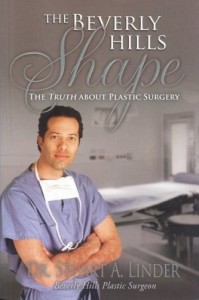Surgical Approaches to Elective Breast Augmentation
Posted On: November 19, 2008 Author: The Office of Dr. Stuart Linder Posted In: Breast Augmentation, Home
There are many ways of skinning a cat and there are many ways of performing a breast augmentation. Some ways are simple, standard, predictable and safe. Other ways are more unpredictable and difficult to get perfect symmetry and may lead to increased risk of both immediate operative and postoperative complications. We enjoy doing the periareolar approach, incisions made underneath the areola, from approximately the 5 o’clock position to the 7 o’clock position. It is usually about a 2.5 to 3.5 cm incision along the boundary border of the areola. Usually these scars heal very well, they camouflage well and have a low incidents of keloiding or hypertrophic scarring. By placing the implants through the periareolar approach, it is easy to go subpectoral (behind the muscle) using the dual plane technique and to place the implants accurately, releasing the pectoralis major muscle along the parasternal and along the inframammary fold, accurately and precisely. This allows for more accurate cleavage and inframammary fold symmetry.
 Other approaches have been performed throughout the years, including the inframammary incision. This is a standard approach, which is safe. However, working uphill from the inframammary fold superiorly, in my thoughts and opinions, is more difficult than the periareolar in order to centralize the implants directly in the middle of the breast. In other words, working along the middle of the breast, centralizing the implant, is easier than working uphill through the inframammary approach. The tubular breast approach, placing the implant through the umbilicus, in my theory is difficult, unpredictable and probably has higher rate of complications. Placing an implant through the belly button all the way up underneath the muscle accurately, seems difficult, if not impossible, at least in my mind. If the surgeon is going to do hundreds, if not thousands of implants annually, we need to reduce our rate of recurrence of scar tissue, of asymmetry, and of malposition of implants. The tubular breast in my thoughts is not the way to go.
Other approaches have been performed throughout the years, including the inframammary incision. This is a standard approach, which is safe. However, working uphill from the inframammary fold superiorly, in my thoughts and opinions, is more difficult than the periareolar in order to centralize the implants directly in the middle of the breast. In other words, working along the middle of the breast, centralizing the implant, is easier than working uphill through the inframammary approach. The tubular breast approach, placing the implant through the umbilicus, in my theory is difficult, unpredictable and probably has higher rate of complications. Placing an implant through the belly button all the way up underneath the muscle accurately, seems difficult, if not impossible, at least in my mind. If the surgeon is going to do hundreds, if not thousands of implants annually, we need to reduce our rate of recurrence of scar tissue, of asymmetry, and of malposition of implants. The tubular breast in my thoughts is not the way to go.
The transaxillary approach has been used for many, many decades and can have favorable results in the right experienced surgeon’s hands. I, however, believe there are a significant number of double-bubble deformities, especially with patients with ptotic breasts, that is sagginess to the breasts, where the implants end up too high (superiorly retropositioned) and the skin over-drapes the implants. This I see on my breast revision patients throughout the United States who present for repair all the time. Therefore, in my opinion, the periareolar approach is the safest, most predictable approach in performing elective augmentation mammoplasty procedures, either with silicone or saline implants.